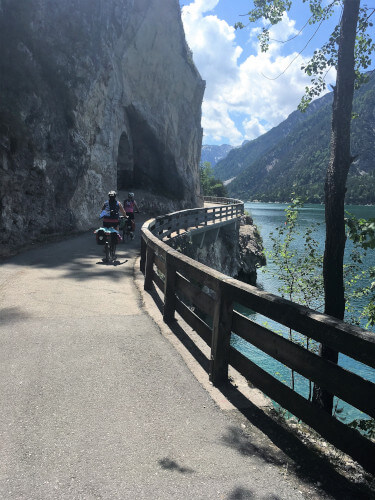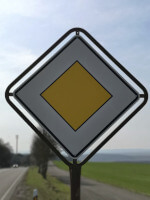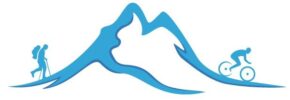

Bicycle Touring Tips
It is one of our favorite ways to experience the Alps. Thanks to the extensive network of designated bicycle paths and routes, crossing the Alps on a bicycle delivers a comprehensive experience that can't be matched. Tourers receive perfect doses of culture as they cross borders, ride through the famous European cities and quaint villages; alternated with with the perfect balance of nature and awe-inspiring mountain vistas.
We love bicycle touring because of its flexibility. Tours can be made easier by shortening days and extending the overall duration of the trip, bypassing some of the difficult climbs by train or bike shuttle, or even by renting an e-bike. Many bicycle tourers in the Alps take it easy, and enjoy their overnights in 4-star hotels, including in historic castle hotels, while others keep it budget-friendly and affordable. We arrange bicycle tours on all ends of the financial and fitness spectrums for our customers. Even if you don't do bicycle touring in your home country, we strongly recommend it in the Alps.
Is bicycle touring in the Alps right for you?


We think it just might be! Our bike tours are not targeted toward the hard-core multi-month bicycle touring community, but rather toward avid hikers and athletes who also happen to know how to ride a bike. Let's play a quick round of fact versus fiction.
Fact: You do need to already know how to ride a bike
It is important to have the basics down, such as braking and shifting. For our trans-alps tours (Munich to Venice and Fuessen to Lake Garda), knowing how to shift appropriately becomes even more important.
Fiction: You need to own or buy a lot of cycling gear
Absolutely not! Check out our Packing section below, but you can get by mostly with your hiking gear. We will make a few recommendations of items that you can purchase, and we can arrange for bike rental and pannier rental (the bags that carry your gear on the bike) for you upon arrival in Europe.
Fact-ish: Bike touring requires a good level of fitness
Well, kind of. If you are able to extend the duration of your tour, you can shorten your days significantly. One of our Alps crossings even offers a bike shuttle up and over every pass if desired. We can arrange for an e-bike rental, and if that isn't enough, we can offer you a completely flat bike tour. So, definitely train and prepare, but there is a lot we can do to ease the physical demands of a tour. If you are fit, and are looking for a physical challenge, we can arrange for that too.
Happy Bum, Happy Tour
This is something that might not make your tour, but it certainly can break it if not given the right attention. It is really important to know that your bum does not have to hurt on a bike seat! Proper planning and preparation will really pay off here. Watch the video here as early as you can before your bike tour, so you can start thinking about this. Here are some of the main points:
- A softer seat will NOT make you more comfortable! In fact, it will create more friction, which is likely to lead to saddle sores
- The fit of your saddle is critical. If renting a bike, consider bringing your own bike seat
- Avoid having any seams in your clothes between your bum and the bike seat (again, avoid friction)
- You get what you pay for when purchasing bike shorts
Be proactive on tour! Once you feel pain, find something to change.
Waiting can lead to painful consequences for the entire tour!
Additional External Resources
Please let us know if any of the links provided are not working
How to Pick Your Bibs (shorts)
How to Measure Sit Bone Width
Packing for Your Bike Tour
One of the great things about bike touring is that you probably already own most of the gear. At Alpenventures UNGUIDED, we do not recommend spending a lot of money on cycling-specific gear prior to your tour. We go into detail in the video here.
The only cycling-specific gear we absolutely recommend you bring with you on tour are:
-Water bottle
-Chamois cream (or diaper cream)
If you would like to purchase additional cycling gear, here are our recommendations, in order of priority:
1. High-quality chamois or bike short
2. Cycling gloves
3. Cycling vest
Traffic Laws
Each cyclist needs to know, understand, and adhere to the traffic laws in each individual country in which they cycle. Alpenventures UNGUIDED does put great effort into ensuring our tours avoid motor vehicle traffic as much as possible, but there are still sections, whether it be going through a small village or a construction detour, where our customers will end up on a road.
One of the best resources we have found, that covers traffic laws from a cyclist's perspective, is this summary of German Bicycle Laws. However, we encourage all of our bike touring customers to review the laws, and in particular, the signage, for each country they will be cycling in. Internet search engines will pull up great resources for this.
On this page, we are going to emphasize a few laws that are critical for cyclists, particularly those coming from N. America. This is not an exhaustive resource. Please do your own additional research.






Right has the right of way
If you are coming from N. America and just thought "Yes, for us too," please stop and read this in detail! It is very different here, and not understanding this difference can be dangerous.
There are many unmarked intersections in Europe, particularly in small villages and in neighborhoods. The rule at these intersections is that the person to the right has the right of way. It sounds like N. America, right? Well, not at all. In N. America the vehicle that arrives first at the intersection has the right of way, and only if two or more vehicles arrive at the same time, does the right before left rule apply. In most of Europe (at least in the countries in the Alps), it doesn't matter who arrives first at the intersection. Even if you are there first, if a car is coming from the right, you have to stop.
Here is how this plays out in real life, and why this can be dangerous. Many drivers arrive at an unmarked intersection, and ONLY LOOK RIGHT. They trust that the person to their left will do the same as well, and yield to them appropriately. So, they don't even look, and may continue even if somebody is coming from the left. This is beautifully efficient when everybody executes correctly, but disastrous when the other driver or cyclist fails to look right, and just rides straight through the intersection.
In short, when arriving at an unmarked intersection, LOOK RIGHT. If there is a car approaching the intersection that would be required to brake or slow down if you cross, then stop.
We strongly encourage watching this video on the Right of Way prior to your tour! This will help you understand some of the complexities of this law.
There are a few exceptions when the right before left rule does not apply:
1. You are on a priority road. This is indicated by a sign with a yellow diamond (pictured). Attention: a yellow diamond with lines through it indicates the priority road ends, and the right before left rule comes back into play.
Note: If the priority road turns, there will be a sign indicating the turn, and which direction has the priority. We won't go into detail here, but look for that in your research.
2. There is a Right of Way sign at, or just before, the intersection (pictured).
3. The road to the right comes from a parking lot, gas station, or pedestrian zone (indicated by raised pavement, usually out of bricks or cobblestones).
Since we are talking about turning right, it is also good to know that right turns on a red light are not allowed, unless a green turn arrow is present. This law enhances cyclist and pedestrian safety significantly.
Directional Priority
Roads in Europe can get quite narrow, particularly in Italy, and particularly in the mountains. There are just a couple things to know about this:
1. You may see the sign to the right when the road narrows to one lane. If the white (or sometimes black) arrow goes in your direction, you have the right of way, and oncoming traffic must yield. If the arrow is red in your direction, then you need to yield to oncoming traffic.
2. Often in Europe, legally parked vehicles will turn a two-lane street into a one-lane street. In this case, the traffic driving on the side where there is a blockage (a parked car, for example) has to yield to the oncoming traffic.




STOP!
If you see either of these signs, do not proceed. Bicycles are not allowed, and you probably do not want to ride there anyway. The sign on the left indicates an autobahn or freeway, and the sign on the right only allows motor vehicles.


Additional External Resources
Please let us know if any of the links provided are not working
Adjusting Your Bicycle for Comfort
Cycling requires repetitive movement. If you do not have the right fit, injury is possible. We encourage all cyclists to take bike fit seriously, and to invest time in adjusting your bicycle for maximum fit and comfort.
If you will be renting a bicycle, plan to stop frequently on the first day (and maybe even the second) for adjustments. Keep your tools conveniently accessible, and pay attention to your body. Be proactive. If there is pain or discomfort, adjust something. Keep adjusting until that goes away. If you let pain set in early in the tour, it will stay with you the entire time.
We made this video about adjustments that can be made to solve common problems. We also recommend keeping the following article with you on tour (saved on your smart phone or printed out), to use as a resource along the way: Fine Tune Your Bike Fit.
Additional Resources
Please Let us Know if any of the external links are not working
Article: How to Train for a Week-Long Bike Tour
Video: Proper Position on a (Touring) Bicycle
note - this video promotes a position appropriate for touring, but not for road or mountain biking
Course Schedule - search for your location: REI Bicycle Repair Courses (USA)
Course Schedule - search for your location: Globetrotter Bicycle Repair Courses (Germany and in German)
Video: How to Change Gears on Bicycle. Correct Shifting
